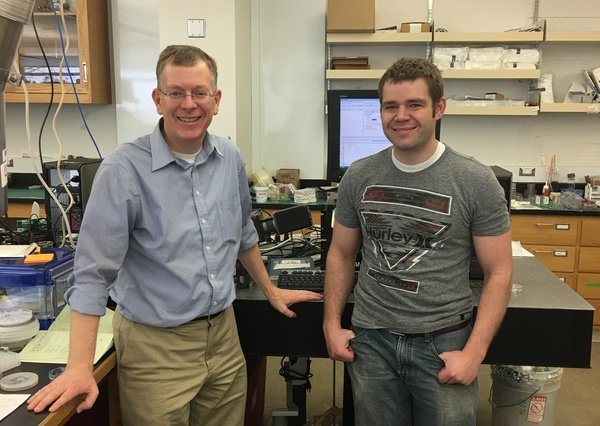Dr. Matthew Linford and Cody Cushman take strides in spectroscopic ellipsometry
Feb. 21, 2017

Chemistry professor Dr. Matthew Linford and chemistry graduate student Cody V. Cushman were featured on the cover of Surface Science Spectra (SSS) for their studies in spectroscopic ellipsometry. This research is funded by Corning Incorporated who is also the manufacturer of the material that was analyzed. The journal functions as a peer-reviewed database for surface spectra of materials whose purpose is to archive reference spectra of materials using surface analytical equipment. The chemistry at the outer few nanometers of a material is of high importance especially when it comes to semiconductors, microfabricated devices, and chemical sensors. “As far as the journal is concerned, I think it's a huge milestone that they've published their first ellipsometry studies. I think this will be really valuable to the thin film community as practically all semiconductor devices, including liquid crystal displays, rely on micropatterned thin films to define their circuitry. These articles will provide useful reference spectra for future ellipsometry studies, and they also act as valuable references about how to perform ellipsometry analysis on certain types of materials,” says Cushman.
Linford and Cushman recently started archiving spectroscopic ellipsometery data with SSS. Ellipsometry is an optical technique that can provide a lot of useful information. Cushman explains: “It is mostly used for analyzing thin films, and it can provide information about the material's identity, their thickness, their band gap and conductivity, their nanoscale roughness, their density, etc. We are among the first to submit a spectroscopic ellipsometry study to SSS. The material we analyzed was Eagle XG, a specialized glass substrate used for making flat panel displays. In fact, odds are pretty good that your smartphone, laptop, or television have a few pieces of this glass in it.”
The team’s current studies in the surface chemistry of glass prompted them to begin analyzing Eagle XG. Cushman elaborates: “The spectroscopic ellipsometry characterization really started as a side project, but it took a lot of work from a lot of people to get it published. I recorded the raw data, built a model to explain the data, extracted the optical constants of the material, and otherwise did the bulk of the writing on this."
Brandon Sturgell contributed sufficiently towards the data processing and figure preparation for the publication and served as Cushman’s undergraduate co-author on this project. Cushman also attributes part of his success to the input of Andrew Martin, an engineer at J. A. Woollam Incorporated, whose company manufactured the team’s ellipsometry instrument. In addition, Nicholas Smith, the project leader at Corning, and Dr. Barry Lunt, a BYU Professor in Information Technology, provided a lot of useful input during the editing process of this project.
“For me personally, this project was a great way to become well-versed in ellipsometry. I had learned a little about the technique before this, but it's a lot different taking a class on a technique and learning enough about it to get published in a peer-reviewed journal. I've still got a lot to learn when it comes to this technique, but I feel like I've gotten my wings now,” said Cushman.
Writer: Taelin Wilford
Photographer: Dhruv Shah